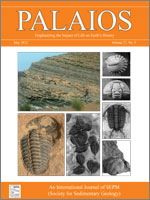Shaanxilithes ningqiangensis is an enigmatic ribbon-shaped fossil from the upper Ediacaran Gaojiashan Member of the Dengying Formation, southern Shaanxi Province, South China. This taxon has also been reported from Ediacaran successions in North China and possibly in Siberia, making it a potential index fossil for interregional biostratigraphic correlation of upper Ediacaran successions. At Gaojiashan, Shaanxilithes ningqiangensis is often preserved along bedding planes of phosphate-rich silty and calcareous shale, with no evidence of vertical intrusion into adjacent beds and containing little to no carbonaceous material. Here, through detailed microstructural and microchemical investigation using a combination of analytical techniques, taphonomic details of Shaanxilithes ningqiangensis and potentially related forms are revealed, showing that these enigmatic fossils are preserved as clay molds. Together with other taphonomic features, such as abruptly bent ribbons, overlapping but not crosscutting ribbons, and co-occurring discoidal structures interpreted as disarticulated sections of the original organism, the new data suggest that Shaanxilithes ningqiangensis is a body fossil consisting of serially arranged units that are discoidal, lensoidal, or crescentic in shape. Shaanxilithes ningqiangensis is not a trace fossil as some previous researchers have suggested.
BioOne.org will be down briefly for maintenance on 17 December 2024 between 18:00-22:00 Pacific Time US. We apologize for any inconvenience.
How to translate text using browser tools
1 May 2012
TAPHONOMY OF THE UPPER EDIACARAN ENIGMATIC RIBBONLIKE FOSSIL SHAANXILITHES
MIKE MEYER,
JAMES D. SCHIFFBAUER,
SHUHAI XIAO,
YAOPING CAI,
HONG HUA
ACCESS THE FULL ARTICLE
It is not available for individual sale.
This article is only available to subscribers.
It is not available for individual sale.
It is not available for individual sale.
<
Previous Article
|

PALAIOS
Vol. 27 • No. 5
May 2012
Vol. 27 • No. 5
May 2012




